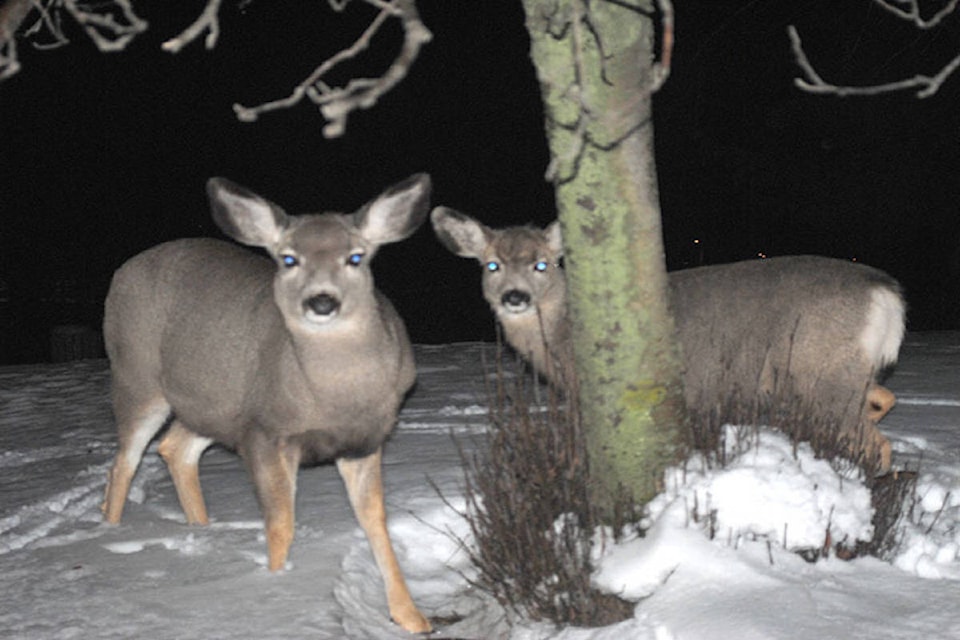To the editor, Mayor and Council, �������� Residents:
I write in response to the story in the �������� on Tuesday July 25 titled “Deer cull petition gathers more than 1,000 signatures”
I was concerned to read the article which alluded to Upper Mission residents wishing a deer cull in our neighbourhood.
As a long-time resident of the �������� Upper Mission community, I wish to make it known that my household was approached and asked to support a plan for bringing awareness to council of the urban deer situation. My husband and I spent some time in conversation to understand the concerns and we stipulated that we do not support a cull.
There were three options presented on the petition that had been used in other communities:
1) Best outcome deer contraception 2) Deer relocation; tried in the past and known to be ineffective 3) Euthanasia which was presented as not the option they or others would prefer.
In response to discussing these three options and drawing on my experience working with wildlife as branch manager for the BC SPCA �������� and as an accredited member of IWRC (International Wildlife Rehabilitation Council), I added my name to the awareness petition which was only to bring forward concerns to council that the urban deer population is increasing and that we must find a way to co-exist. I even added a notation that we only support a humane program where we can co-exist.
I offered my voice to spearhead a community group, meet with mayor and council, RDCO and conservation officers, connect with local media groups and other key stakeholders and use my skills and experience to work collaboratively with community leaders and the public to develop a robust, factual and evidence based management plan.
I provided my details yet since our initial conversation have had no further contact. In conversation with other neighbours the consensus is for a humane education plan to be introduced where we can be community leaders and find a way as a community to co-exist with wildlife without the need to kill urban animals. I also recommended they consult with the team at Urban Wildlife Stewardship Society (UWSS.CA) based in Victoria who represent one of the best Urban Deer community groups in operation.
I feel the awareness petition was misrepresented, not only to my household and other community residents, but also to Mayor and Council and public and I wish to present some lengthy yet evidence based facts. Please read on. As we now know from , and as respected wildlife biologists state, “experience and science demonstrate over and over that culls do not work.”
We know from experience in communities such as Oak Bay and their disastrous cull of 2015 that poor, unsubstantiated plans are both divisive and ineffective. Scientific evidence proves the folly of approaching a deer management plan backwards: A plan that is without being evidence based is a deer reduction plan that can backfire.
Based on Oak Bay’s experience and the division and ineffectiveness this caused it is recommended that a number of steps are taken which include public education, a value based survey and a deer count, as the first steps in any successful deer management program. Deer reduction shouldn’t even be considered until these steps have been undertaken diligently. As evidence suggests, prior to any best practice model for deer management we must start with completing a comprehensive public survey which is showcased in the Esquimalt community action plan, delivered to 1,100 households with a 47 per cent response rate.
The Esquimalt model is a great example of a community that is engaging all stakeholders and implementing a best practice model for deer management. The public survey was completely unbiased and had no questions around methods for deer reduction. It was to determine what kinds of interactions people had with deer, how they felt about deer, how many they see and provided valuable information.
Based on the information from the survey, Esquimalt began a public education campaign. Esquimalt is organizing a deer count in the fall which should be done annually to determine how many deer are present and what the trends are. Experience also suggests that usually there are fewer deer than the public realize. Oak Bay is also now planning to implement a model of immuno-contraception so that the province has another tool to offer communities such as ��������: A non-lethal alternative which also avoids the problems around in-migration after a cull, as well as reproductive rebound, as seen after the Cranbrook cull.
The idea is to stabilize the population in areas where deer are of concern (which the survey helps identify), and reduce it over time. This avoids the “nature abhors a vacuum” situation. I welcome the opportunity to meet with Mayor and Council and cannot stress enough the importance of public education to learn how to co-exist with urban wildlife and implement a collaborative and robust scientific, evidence based, deer management program.
Please consider visiting the website and blogs at uwss.ca where you will see the effective, collaborative approach that is underway in Esquimalt. Let’s be progressive in our approach to managing urban wildlife.
Suzanne Pugh, Former Branch Manager �������� BC SPCA



